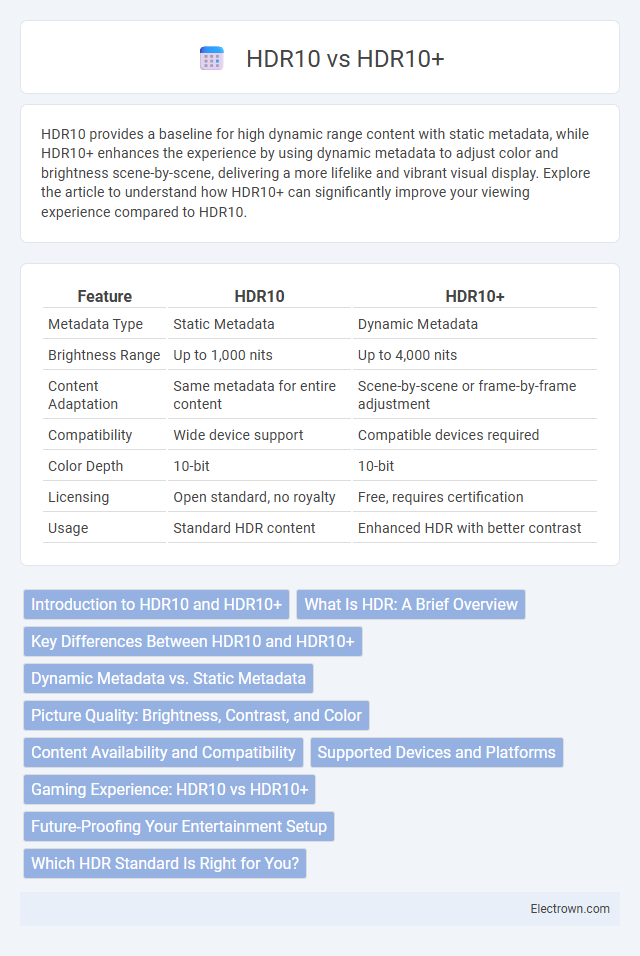HDR10 provides a baseline for high dynamic range content with static metadata, while HDR10+ enhances the experience by using dynamic metadata to adjust color and brightness scene-by-scene, delivering a more lifelike and vibrant visual display. Explore the article to understand how HDR10+ can significantly improve your viewing experience compared to HDR10.
Table of Comparison
| Feature | HDR10 | HDR10+ |
|---|---|---|
| Metadata Type | Static Metadata | Dynamic Metadata |
| Brightness Range | Up to 1,000 nits | Up to 4,000 nits |
| Content Adaptation | Same metadata for entire content | Scene-by-scene or frame-by-frame adjustment |
| Compatibility | Wide device support | Compatible devices required |
| Color Depth | 10-bit | 10-bit |
| Licensing | Open standard, no royalty | Free, requires certification |
| Usage | Standard HDR content | Enhanced HDR with better contrast |
Introduction to HDR10 and HDR10+
HDR10 is an open standard for high dynamic range (HDR) video that uses static metadata to enhance brightness, contrast, and color accuracy across all scenes uniformly. HDR10+ builds upon HDR10 by incorporating dynamic metadata, allowing for scene-by-scene or frame-by-frame adjustments, resulting in more precise and vivid picture quality. Both formats support 10-bit color depth and a peak brightness of up to 1,000 nits, but HDR10+ provides a more immersive viewing experience through adaptive tone mapping.
What Is HDR: A Brief Overview
HDR10 and HDR10+ are advanced High Dynamic Range (HDR) formats designed to enhance your viewing experience by delivering superior contrast and vibrant colors compared to standard dynamic range (SDR). HDR10 uses static metadata to apply a single brightness and color profile across the entire video, while HDR10+ employs dynamic metadata that adjusts these settings scene-by-scene or frame-by-frame for more precise image optimization. Understanding the distinction between HDR10 and HDR10+ helps you choose compatible devices and content that maximize the visual quality of HDR displays.
Key Differences Between HDR10 and HDR10+
HDR10 uses static metadata to apply a single tone mapping curve throughout the entire video, while HDR10+ uses dynamic metadata to optimize brightness and contrast scene-by-scene or frame-by-frame. HDR10+ supports dynamic tone mapping, resulting in more accurate and immersive HDR experiences compared to HDR10's fixed tone mapping. Compatibility is broader for HDR10 as it is widely adopted across devices, whereas HDR10+ requires specific hardware and software support for dynamic metadata processing.
Dynamic Metadata vs. Static Metadata
HDR10 uses static metadata, applying fixed brightness and color settings throughout the entire video, which can limit the visual accuracy on scenes with varying lighting. HDR10+ employs dynamic metadata, allowing scene-by-scene or frame-by-frame adjustments to brightness and contrast, enhancing detail and color reproduction in each segment. This dynamic metadata enables HDR10+ to provide a more precise and optimized viewing experience compared to the static metadata approach in HDR10.
Picture Quality: Brightness, Contrast, and Color
HDR10+ enhances picture quality by dynamically adjusting brightness, contrast, and color on a scene-by-scene basis, offering more precise and vivid visuals compared to the static metadata used in HDR10. The dynamic metadata in HDR10+ allows for higher peak brightness levels and improved contrast ratios, resulting in deeper blacks and brighter highlights. HDR10+ also delivers richer and more accurate color representation, making images appear more lifelike and immersive.
Content Availability and Compatibility
HDR10 content is widely available across streaming platforms, UHD Blu-rays, and broadcast services, making it the most common HDR standard supported by a vast range of devices including TVs, gaming consoles, and media players. HDR10+ introduces dynamic metadata for enhanced picture quality but has more limited content availability, with select titles on Amazon Prime Video and UHD discs, and is compatible mainly with newer TVs from brands like Samsung and Panasonic. Compatibility constraints for HDR10+ mean users often rely on HDR10 for broader content access, while HDR10+ offers improved scene-by-scene optimization where supported.
Supported Devices and Platforms
HDR10 is widely supported across various devices and platforms, including most 4K TVs, Blu-ray players, gaming consoles, and streaming services like Netflix and Amazon Prime Video. HDR10+ extends compatibility by adding dynamic metadata, but support is more limited, available primarily on Samsung and Panasonic TVs, select UHD Blu-ray players, and Amazon Prime Video. To ensure the best HDR experience, your device must explicitly support HDR10+ to take full advantage of its enhanced picture quality.
Gaming Experience: HDR10 vs HDR10+
HDR10+ enhances the gaming experience by providing dynamic metadata that adjusts brightness and contrast scene-by-scene, offering more accurate HDR visuals compared to the static metadata of HDR10. This results in improved detail in dark or bright areas, reducing the risk of washed-out images or loss of detail during fast-paced gameplay. Gamers using HDR10+ compatible displays enjoy a more immersive and vibrant experience, with better color accuracy and consistency across different gaming environments.
Future-Proofing Your Entertainment Setup
HDR10+ enhances future-proofing your entertainment setup by dynamically adjusting brightness and contrast scene-by-scene, offering superior picture quality compared to static metadata in HDR10. With wider adoption by major TV manufacturers and streaming services, HDR10+ ensures compatibility with the latest content and devices, safeguarding your investment. Choosing HDR10+ equips your system to handle evolving HDR standards and delivers a more immersive viewing experience over time.
Which HDR Standard Is Right for You?
HDR10 offers a widely supported, baseline high dynamic range experience with static metadata, ensuring consistent brightness and color quality across compatible devices. HDR10+ enhances this by using dynamic metadata to adjust brightness and contrast scene-by-scene, delivering more precise visuals and richer details. Your choice depends on whether you prioritize broad compatibility with solid performance (HDR10) or superior, adaptive picture quality for supported content and devices (HDR10+).
HDR10 vs HDR10+ Infographic

 electrown.com
electrown.com